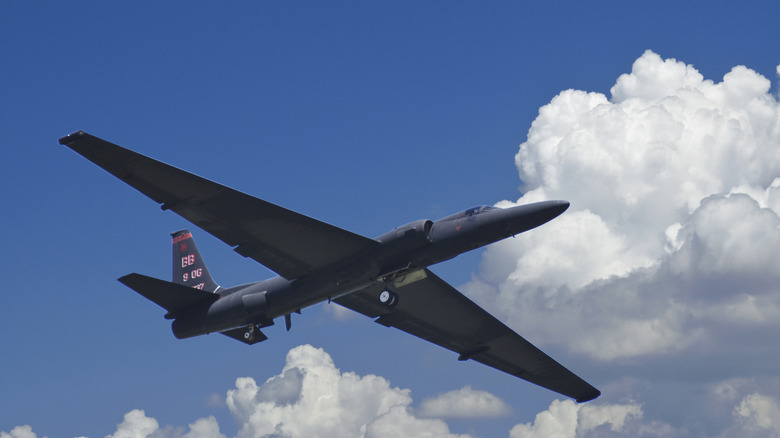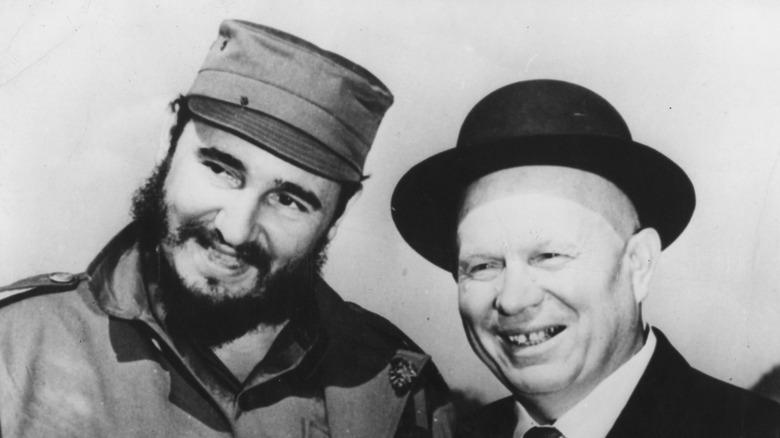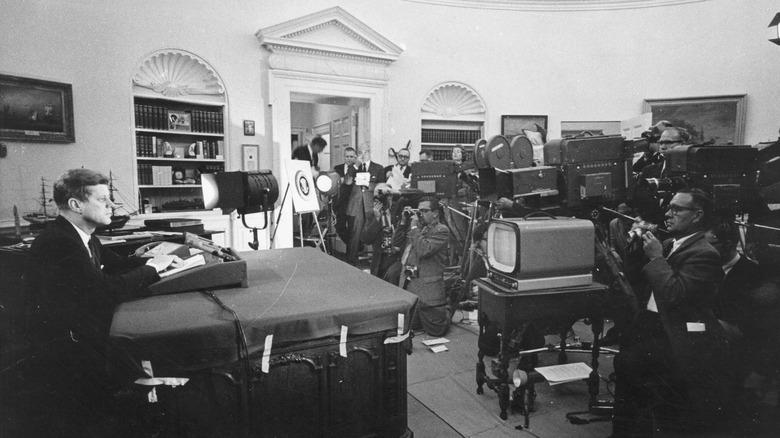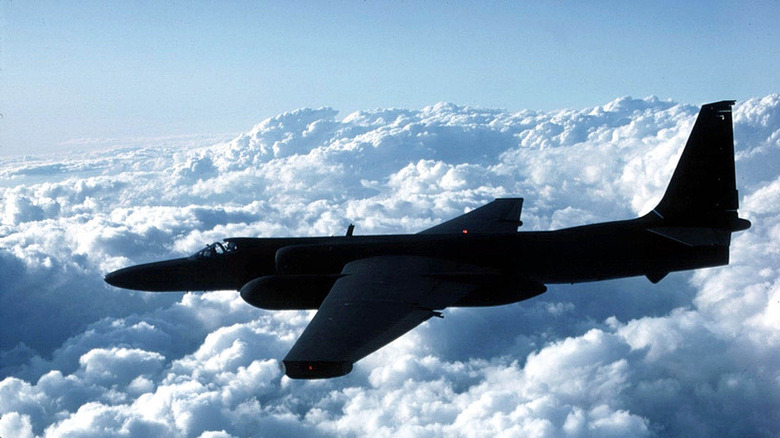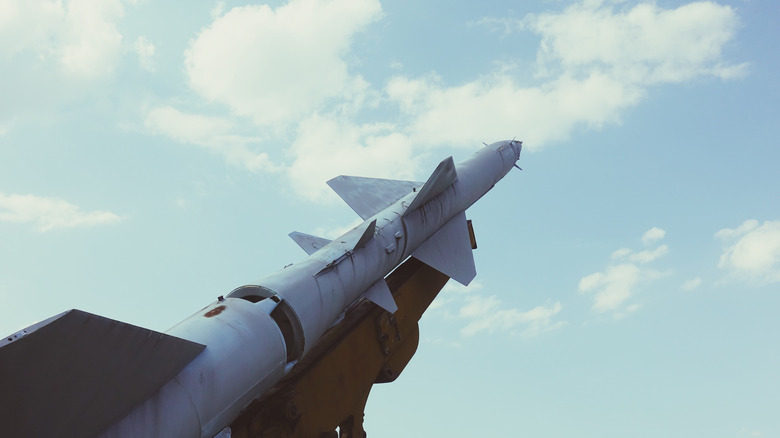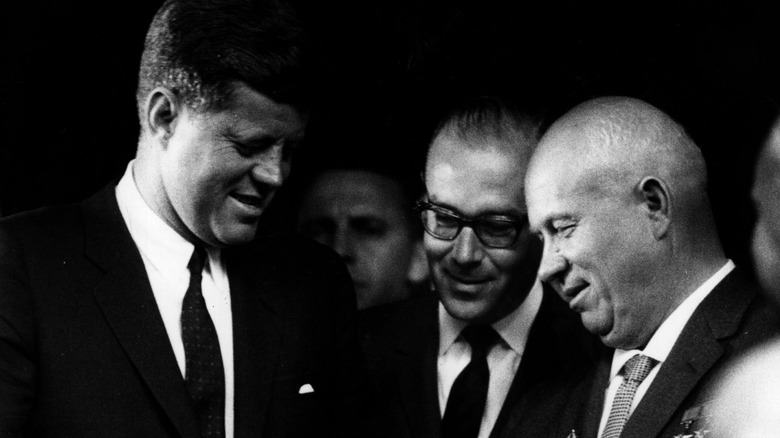The Only Casualty Of The Cuban Missile Crisis Actually Prevented Nuclear War
In a decades-long period of time where tensions were about as high as they could ever be, at no point during the Cold War did American and Soviet powers that be have the fingers hovering closer to the nuclear weapon launch button than during the Cuban Missile crisis. It was one of the defining moments in John F. Kennedy's presidency.
Just over a year before his assassination, Kennedy was responsible for navigating a tenuous situation where if he put a foot wrong it would've meant millions of people dead. Thankfully, the stand-off ended without further incident following the death of one United States casualty. His name was Rudolph Anderson, a pilot in the United States Air Force, who was shot down over Cuba. According to History, his death served as a reality check for Kennedy and his Soviet counterpart Nikita Khrushchev and led to the de-escalation of the crisis unfolding less than 100 miles from the United States coastline (via History).
The lead-up to the Cuban Missile crisis
Following World War II, the United States and Soviet Union — who had worked together to defeat the Nazis in Europe, albeit begrudgingly, per the National World War II Museum — were the two undisputed world powers, but they held significantly different world views that pitted them against each other for nearly 50 years.
Following the United States' decision to drop a pair of atomic bombs on Japan to end the war, the Americans and Soviets engaged in a nuclear arms race, with the two nations competing to build bigger, more powerful weapons. In the late 1950s, a revolution in Cuba saw communist Fidel Castro take control of the island nation situated not far from the United States. Castro's regime allied itself with the Soviets — a deal which was sealed when Castro delivered a multi-hour speech criticizing the United States — giving them a foothold close to their greatest adversary (via Britannica).
The crisis begins
On October 14, 1962, an American U-2 spy plane flew over Cuba. When it returned, pictures it had taken revealed something troubling: a soviet missile was being installed on the island. The missile's proximity to the United States posed a new threat, and Kennedy gathered some of his closest advisors to help him navigate the mounting ordeal, per History.
Khrushchev saw this as an opportunity to give the United States, which had installed missiles in Turkey and other parts of Europe, a taste of its own medicine. The Soviets had used the "enemy of my enemy is my friend" approach in partnering with Cuba. Cuban animosity was high following the failure of the Bay of Pigs invasion in 1961, and the Soviets were sure that for that reason Castro would allow the missiles in his country, and they were right.
Kennedy took a week to spitball ideas with his advisors. According to the John F. Kennedy Library, the president decided to put a naval blockade in place to try to prevent further Soviet supplies from arriving in Cuba. In addition, he demanded that the Soviets remove their missiles and destroy the sites that had been constructed for them. On October 22, the president appeared on television to inform the nation that missiles pointed at the United States were based merely 90 miles away.
The United States launched Operation Brass Knob
The flight that discovered the evidence of Soviet missiles on Cuba was part of the United States' Operation Brass Knob. The operation had been approved several days before, and upon the realization of what was unfolding, they decided to schedule more flights to take additional photos of the island (via The Clio).
One of the pilots who flew several of the missions was Rudolf Anderson Jr. Anderson was from Greenville, South Carolina, and attended Clemson University, where he had graduated with a degree in textile management in 1948 (via Clemson Alumni). By 1962, he was well into his military career and was a part of the 4080th Strategic Wing, which was based at Laughlin Air Force Base near Del Rio, Texas, not far from the U.S.-Mexico border.
Another flight over Cuba — Mission 3127 — was scheduled for October 27, 1962. Anderson was not originally supposed to fly this mission, but he asked if he could be the one to fly that day and was given the opportunity, per History. By that point, the danger had ramped up even further. Two weeks unto the crisis, some of the surface-to-air missiles the Soviets had installed were now operational.
Anderson was shot down
Anderson's mission this time, like the ones before it, required him to fly a U-2 spy plane. According to Britannica, U-2 spy planes are single-seat aircraft that fly at extremely high altitudes. This makes them great for what they were built for — gathering information and surveillance — but they were unarmed.
Anderson entered Cuban airspace nearly 14 miles above the Earth's surface, but nonetheless, his plane was picked up by Soviet radar. They kept an eye on the plane, but after an hour they started to believe that the plane was trying to photograph secret nuclear weapons sites situated close to America's military installation in Cuba, the Guantanamo Bay Naval Base (via History). Eventually, Soviet Lieutenant General Stepan Grechko ordered his man to shoot down the spy plane. Grechko took it upon himself to issue this directive. Typically a higher-ranking officer was the only one able to give that kind of order, but with no commanding general available, Grechko did it himself and put the entire world even closer to the brink of all-out war.
The Soviets launched two missiles, one of which exploded close to Anderson's plane. Shrapnel from that blast tore through the cockpit and his flight suit — both of which had to be pressurized due to the U-2s typical high-altitude flying — and it's believed that this killed him instantly.
The reaction to Anderson's death
The same day that Anderson was shot down the White House had already been dealing with another issue when a different U-2 spy plane inadvertently flew over Cuba which led the Soviets to scramble fighter jets (via History). When the news of the downed spy plane reached the White House many of Kennedy's advisors were incensed and wanted him to retaliate on the basis that the Soviets had been responsible for firing the first shots. However, Kennedy trusted his gut feeling that the missiles fired at Anderson's plane had not been ordered by Nikita Khrushchev, and it turned out that he was correct. His decision not to immediately retaliate kept the entire world out of an almost certain war. Kennedy felt that the crisis could be solved through diplomacy, and the death of Rudolph Anderson Jr. showed both sides of the conflict that things could get out of hand in a hurry.
Following his death, Anderson received numerous posthumous accolades. According to Clemson Alumni, he was given a posthumous Purple Heart and the first ever Air Force Cross, among other awards. There's a memorial for Anderson in his hometown of Greenville, where he is buried.
